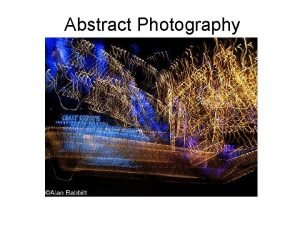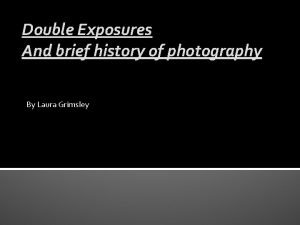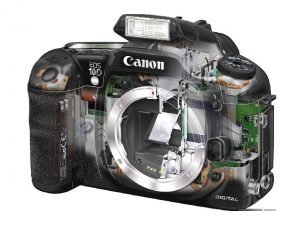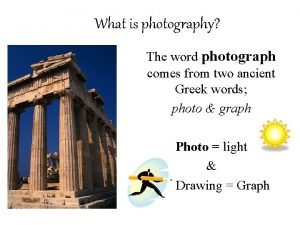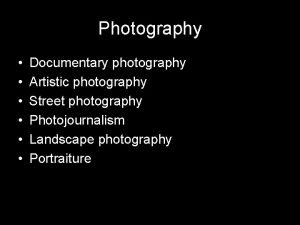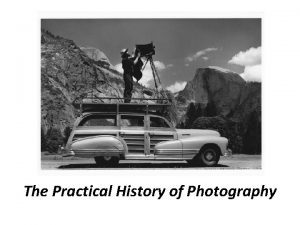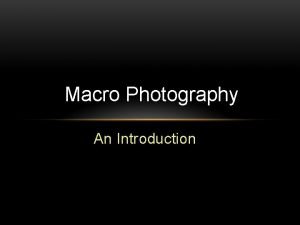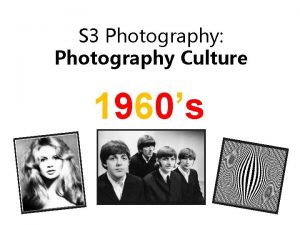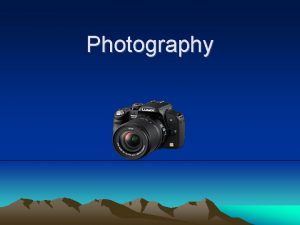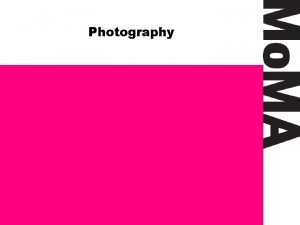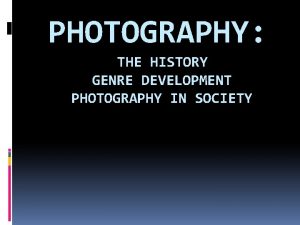Photography I MONDINO History of Photography The word





























- Slides: 29

Photography I MONDINO

History of Photography The word photography comes from two ancient Greek words: photo, for "light, " and graph, for "drawing. " "Drawing with light" is a way of describing photography. When a photograph is made, light is used to record a picture of an object or scene on a light-sensitive surface. Early photographs were called sun pictures, because sunlight itself was used to create the image. Mankind has been a maker of images at least since the cave paintings of some 20, 000 years ago. With the invention of photography, a realistic image that would have taken a skilled artist hours or even days

Cave Drawing

Today, photography has become a powerful means of communication and a mode of visual expression that touches human life in many ways. For example, photography has become popular as a means of crystallizing memories. Most of the billions of photographs taken today are snapshots-casual records to document personal events such as vacations, birthdays, and weddings.

Photographs are used extensively by newspapers, magazines, books, and television to convey information and advertise products and services. A camera can be used in locations too dangerous for humans. Photographs can also be objects of art that explore the human condition and provide aesthetic pleasure. For millions of people, photography is a satisfying hobby or a rewarding career.

Photography as an Art Today photography is widely recognized as a fine art. Photographs are displayed in art museums, prized by collectors, discussed by critics, and studied in art history courses. Because of the special nature of photography, however, this was not always the case. In the early days of photography some people considered the medium something of a poor relation to the older, established visual arts, such as drawing and painting. The arguments stemmed from the fact that a camera is a mechanical instrument. Because the mechanical procedure of taking a picture is automatic, detractors claimed that photography required no coordination of hand eye and none

A camera, no matter how many automatic features it may have, is a lifeless piece of equipment until a person uses it. It then becomes a uniquely responsive tool--an extension of the photographer's eye and mind. A photographer creates a picture by a process of selection. Photographers looking through the camera's viewfinder must decide what to include and what to exclude from the scene. They select the distance from which to take the picture and the precise angle that best suits their purpose. They select the instant in which to trip the shutter. This decision may require

Digital Photography

Digital photography uses an array of electronic photo detectors to capture the image focused by the lens, as opposed to an exposure on photographic film. The captured image is then digitized and stored as a computer file ready for digital processing, viewing, digital publishing or printing.

What makes a good photograph? The shooting styles and photographic resumes of photographers vary greatly, but they all have one thing in common: their work inspires. Their photographs are beautiful to look at, they’re deeply emotive (able to arouse intense feeling), and they should drive you to become better.

What famous photographers say Justin Mott “I always teach my workshop students you want someone to feel something, some sort of an emotion when they look at your images. That could be curiosity, anger, sadness, happiness, etc. The most important element of a photo to me is it’s ability to evoke emotion. ”

Justin is an award winning photographer. He’s worked with The New York Times, Newsweek, Time, Forbes, Conde Nast Traveler, and National Geographic Traveler, just to name a few.

Tanveer Badal “You have to really care about whatever you’re shooting. I know it sounds like a cliché but when I first started taking photos, like most amateur photographers, I would shoot everything in sight. Flowers. Doorknobs. Nascar. It didn’t matter that I didn’t care about pretty flowers, doorknobs or cars going in circles, I just took photos of them because I thought that’s what you’re supposed to do when you’re holding a big camera and something ‘cool’ is in front of you. “After the first million or whatever shots, I stopped my serial shooting spree. Now I don’t shoot as much

Tanveer is a travel and wedding photographer who’s done work from the USA to Bangladesh and everywhere in between.

Jon Reid “After spending 10 years hung up in the technicalities of photography, I’ve come to appreciate that a good photograph is one that causes some sort of emotional response. We’re bombarded with so much imagery that our most common response to photography is indifference. If an image surprises me through an unusual view, wows me through its sheer beauty or makes me angry by showing injustice, it is a good photograph. It could be technically terrible, poorly composed and horribly exposed, but if it causes an emotional response, it will be memorable and therefore successful. ”

Jon and his wife Tina are freelance photographers based in London. Their professional work has been used in magazines, print, web advertisements, and designer look books.

Larissa Olenicoff “Good photographs put you in a particular moment in time, they tell a story, or they speak to your emotions. The most important element of a great photograph is that it does all of the above. ”

Larissa does things with her i. Phone that make me and my fancy DSLR envious. Her creativity permeates her photos through her beautiful editing style.

Dario Endara “The most important element of a good photograph is the ability of the photo to communicate with the viewer. It should be able to tell a story through its composition, lighting, and most importantly its subject matter. ”

Dario is an American photographer living in the Netherlands. He shoots a wide variety of genres including travel, wedding, portrait, and underwater scenes. His goal is to cover as much of the globe as possible, and he’s well on his way having visited more than 30 countries.

Other Aspects of “Good Photography” Elements and Principles of art LINE SHAPE A shape is a self contained defined area of geometric or organic form. DIRECTION All lines have direction - Horizontal, Vertical or Oblique. Horizontal suggests calmness, stability and tranquility. Vertical gives a feeling of balance, formality and alertness. Oblique suggests movement



BALANCE Balance in design is similar to balance in physics A large shape close to the center can be balanced by a small shape close to the edge. A large light toned shape will be balanced by a small dark toned shape (the darker the shape the heavier it appears to be) GRADATION Gradation of size and direction produce linear perspective. Gradation of of colour from warm to cool and tone from dark to light produce aerial perspective. Gradation can add interest and movement to a shape. A gradation from dark to light


REPETITION Repetition with variation is interesting, without variation repetition can become monotonous. CONTRAST Contrast is the juxtaposition of opposing elements eg. opposite colours on the colour wheel - red / green, blue / orange etc. Contrast in tone or value - light / dark. Contrast in direction - horizontal / vertical.

HARMONY Harmony in art is the visually satisfying effect of combining similar, related elements. eg. adjacent colours on the colour wheel, similar shapes etc. DOMINANCE Dominance gives art interest, counteracting confusion and monotony. Dominance can be applied to one or more of the elements to give emphasis

UNITY Relating the design elements to the idea being expressed in a art reinforces the principal of unity. eg. a photograph with an active aggressive subject would work better with a dominant oblique direction, course, rough texture, angular lines etc. whereas a quiet passive subject would benefit from horizontal lines, soft texture and less tonal contrast.

 Is abstract photography same as conceptual photography
Is abstract photography same as conceptual photography Digital photography history
Digital photography history Film photography history
Film photography history Konsep dasar sejarah adalah
Konsep dasar sejarah adalah Famous abstract photographer
Famous abstract photographer Product photography definition
Product photography definition History of photography assignment
History of photography assignment History of double exposure photography
History of double exposure photography The word photography comes from the greek words
The word photography comes from the greek words The term photography literally translates to
The term photography literally translates to When photography was invented
When photography was invented The word photography is greek for
The word photography is greek for Photography comes from greek word
Photography comes from greek word The word photography comes from the greek words
The word photography comes from the greek words Cetaceo del latin cetus
Cetaceo del latin cetus Hình ảnh bộ gõ cơ thể búng tay
Hình ảnh bộ gõ cơ thể búng tay Bổ thể
Bổ thể Tỉ lệ cơ thể trẻ em
Tỉ lệ cơ thể trẻ em Gấu đi như thế nào
Gấu đi như thế nào Thang điểm glasgow
Thang điểm glasgow Hát lên người ơi
Hát lên người ơi Kể tên các môn thể thao
Kể tên các môn thể thao Thế nào là hệ số cao nhất
Thế nào là hệ số cao nhất Các châu lục và đại dương trên thế giới
Các châu lục và đại dương trên thế giới Công thức tiính động năng
Công thức tiính động năng Trời xanh đây là của chúng ta thể thơ
Trời xanh đây là của chúng ta thể thơ Mật thư tọa độ 5x5
Mật thư tọa độ 5x5 Phép trừ bù
Phép trừ bù độ dài liên kết
độ dài liên kết
